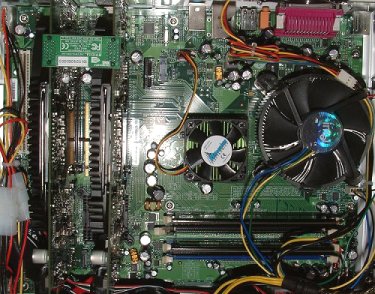Page 2
NVIDIA SLI
Multi-GPU technology isn't something that's just cropped up recently. Going back to 1998, the now-defunct 3dfx realised that the parallel nature of graphics processing just screamed out for a multi-GPU setup. Dubbed SLI (Scan Line Interleave) and thanks to the low bandwidth requirement at the time, a couple Voodoo 2 accelerators could be setup to share the bandwidth afforded by the PCI bus. They worked just as the name suggests, with each card drawing alternate lines. The end result was overall GPU performance that no single card could match.
The introduction of a new motherboard interconnect in 2004, PCI-Express, paved the way for NVIDIA, who bought parts of 3dfx's technology, to re-establish multi-GPU technology. The PCI-Express interface brought about wholesale changes in the way and speed at which devices interacted with the system or one another. Primary graphics cards are run off an x16 slot, which, as the name suggests, offers 16 lanes that each run, bi-directionally, at 250MB/s. Interaction between devices, something that AGP was not able to handle and a prerequisite for true multi-GPU goodness, can also be undertaken without the bus-sharing nature of the PCI protocol. In short, the time was ripe for NVIDIA to bring back some multi-card lovin'. It's worth remembering that SLI is a PCI-Express-only technology.
Tools
NVIDIA's multi-GPU SLI technology needs some certified hardware. First off, you'll need to invest in an SLI-capable motherboard, which, in the main, are currently available in AMD's S939 and Intel's S775 CPU flavours. At the time of writing, all consumer-level SLI chipsets are based around NVIDIA's nForce4 architecture, running from regular nForce4 SLI, through to nForce4 SLI x16, and, finally, nForce4 Professional. What all these chipsets have in common are two x16 electrical slots into which you'll plug 2 SLI-certified NVIDIA graphics cards. The cards need to be of the same model but not necessarily from a single manufacturer, assuming both that both can be flashed to have identical BIOSes.
As mentioned, all chipsets have a primary slot that can offer up to x16 PCI-Express support, but the second, identical in physical appearance, is limited to 'only' x8 (which is still 2GB/s, bi-directionally) on all but the nForce4 SLI x16 chipset. The reasoning is down to the total number of PCI-Express lanes available on each model. The x16, as the name suggests, offers up x16 support on both slots. In normal SLI operation, both cards are remapped to x8, ensuring that the motherboard's PCIe lane limit isn't breached.
The next step is to invest in a couple of SLI-capable video cards, although a single card would work just fine in an SLI motherboard. NVIDIA's current SLI-ready range comprises of the GeForce 7800-series of accelerators at the very top, followed by a whole list of 6-series PCIe hardware which goes right down to the low-end GeForce 6600 LE, costing around £150 for a pair and bringing the entry price for a fully-built SLI system down to palatable levels. The two cards are then linked to one another via an inter-GPU connector (not required on the GeForce 6600 LE, though), with video output emanating from the card in the primary slot. The secondary card's job is simply to provide the extra graphical horsepower that defines SLI and shift it over to the primary card. SLI motherboards also have a motherboard-based connector that needs to be toggled when used in single-card or SLI modes. Some, however, have digital switching.
SLI cards, once installed and configured correctly into a system, both in terms of hardware and software, combine to offer rendering that's greater than a single card's, and it's totally transparent to the user. SLI can be manually enabled for any game, and NVIDIA, through its ForceWare drivers, provides optimised profiles for over 150 current gaming titles.
In terms of process, SLI's done via a couple of methods known as SFR (Split Frame Rendering) and AFR (Alternate Frame Rendering). SFR is when both GPUs in an SLI system combine to work on a single frame at one time. The primary card renders the upper portion and the secondary card the lower portion of the frame. If performance can be improved by having one GPU render a larger portion than the other, intelligent load-balancing techniques can calculate and assign differing workloads. The framebuffer is then combined and outputted on to your display. The inevitable overhead from inter-GPU communication generally limits performance gains, as compared to a single-card setup, to <2x. That's not be sniffed at, however.
Alternate frame rendering's name is also a giveaway. Here, each GPU renders a frame, in its entirety, one after the other, with each buffering when not actively drawing a frame. GPUs don't 'talk' to one another other than to pass the secondary card's data over to the primary card, and all work is more parallel in nature; there's no load-balancing at all. The best method is dependant upon the software that's being used and, of course, SLI only brings about tangible framerate benefits if the game in question is GPU-bound. Half-Life 2, being a CPU-bound game until you hit massive resolutions and/or invoke high degrees of image quality, doesn't benefit much from multi-GPU technology, performance-wise.
Overall thoughts
NVIDIA's SLI technology is now a proven design that has the added attraction of immediate support from GeForce 7800 GTX right down to GeForce 6600 LE. The intrinsic beauty of a multi-GPU setup is that, once you've purchased a compatible motherboard and single graphics card, you can upgrade to full-blown SLI status later. The downside, obviously, is cost. An SLI-compatible motherboard and, say, a couple of GeForce 7800 GTXs won't leave much change from £800. That's a lot to pay for a high-end gaming base, isn't it?

NVIDIA's nForce4 SLI Intel Edition in action. GPUs are tied together with the inter-GPU connector.









